|
FAQs on Sponge Identification
14
Related Articles: Sponges in Marine
Aquariums
Related FAQs: Sponge ID
1, Sponge ID 2, Sponge ID 3, Sponge ID 4, Sponge
ID 5, Sponge ID 6, Sponge ID 7, Sponge ID
8, Sponge ID 9, Sponge ID 10, Sponge ID 10, Sponge ID 11, Sponge ID 12, Sponge ID 13, Sponge ID 15, Sponge ID 16, Sponge ID 17, Sponge ID 18,
Sponge ID 19, Sponge
ID 20, Sponge ID 21, & Sponges 1, Sponges
2, Sponges 3, Sponge Selection, Sponge Compatibility, Sponge Systems, Sponge Feeding, Sponge Disease, Sponge Reproduction,
|
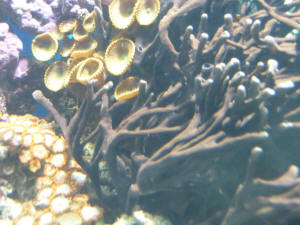
|
|
Re: name of algae, new... -- 02/08/10
Thank you for your quick answer. Can you help me again with this
one? It was taken Again in N-Sulawesi on a house rif in Lembeh
street.
<Ahh! Have spent quite a few vacations at KBR and Lembeh
Resort... there are now some 11 resorts being built and up there,
as well as some boats that come over from the Bunaken/Manado
side>
That same stuff I also found in the Philippines, a year ago, but
could not found out what is was.
Thanks again Bob.
Greetz Tineke
<I don't know what this is... looks like some sort of
Chlorophyte that is overgrowing a stony coral skeleton to me. Did
you happen to touch, move it with your hand that you recall?
BobF>
|
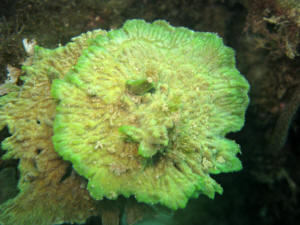 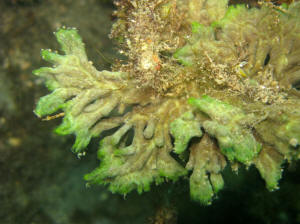 |
Re: name of algae --
02/08/10
Hay Bob....indeed it looks like overgrow of coral. I did found also
the one from the Philippines which I send you now. There is a very
close-up so maybe you can see what it is. But than the first
pictures I send you, there was one who looks like a flower
(886T-5221)...maybe this algae used base as a kind of stabilization
and grow bigger later. I didn't touched it but as I remember it
was on the edges not very *stony*
Greetz Tineke
<I'll be... you know, this close up reminds me of... some
sort of Ascidian colony; with some filamentous Green algae growing
at the apices of the branching. I do wish we had some on hand to
section and look at under a 'scope. Am going to ask LynnZ to
take a look here as well. BobF> |
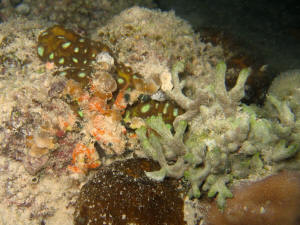 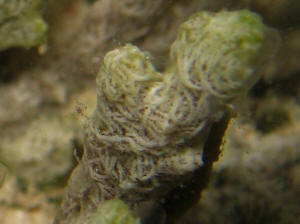 |
Re: name of algae -- 02/09/10
Thank you Bob, I wait till you get an answer. When ever I found
that again I will take a little piece with me...although it is
forbidden (just for sciences :)) unless LynnZ comes with the
name.
I look forwards to the answer!
<Me too Tineke>
Greetz from Holland
Tineke
<And back at you as they say, from S. California. BobF>
Re: Re: name of algae, perhaps a Poriferan --
2/10/10
Thank you Bob, I wait till you get an answer.
<<Hello Tineke and Bob, Lynn here today.>>
When ever I found that again I will take a little piece with
me...although it is forbidden (just for sciences :)) unless LynnZ
comes with the name.
<<Hmmm, I wish I could say that I have, but all I can offer
are more possibilities. One that comes to mind is that what
we're seeing isn't something actually overgrowing a coral
skeleton, but instead perhaps a branching Demosponge, order
Haplosclerida, all by itself. Perhaps the sponge is dead and has
a growth of some sort of filamentous algae covering the
openings/osculae at the tips? Apparently, these sponges are found
around the Philippines. I'd feel a whole lot more confident
though, if I could find and see a close-up of one, but I
haven't been successful. I know that these sponges are very
fibrous but I'm not sure if they're as ropy-looking as
what I see in your close-up photo.
If it's not a branching sponge, then I'm guessing
it's some sort of Chlorophyte or Phaeophyte overgrowing a
coral skeleton. What bothers me about this theory is that the
entire winding mass appears almost too smooth and web-like in its
covering of the skeleton. If this were an algae, it seems like
there would be stem ends extending here and there from the mass,
especially considering the fact that it winds around some fairly
narrow branches. I don't see any. Everything just seems a
little too close and compact.
One last possibility I looked into was an Ascidian/tunicate
overgrowing a coral skeleton. Unfortunately, I didn't have
much luck finding any suitable candidates. Of the three I
mentioned, I'm leaning towards the sponge, especially after
having seen the first link below (note the small osculae).
Sponge, order Haplosclerida. See photo under 'Sponge pictures
of week 3':
http://www.naturalsciences.be/active/expeditions/archive2005/patagonia2/page5
Another sponge in this order, found in Hawaii and the Philippines
(note branching variety):
http://www2.bishopmuseum.org/HBS/invertguide/species/gelliodes_fibrosa.htm
Ascidian overgrowing coral:
http://life.bio.sunysb.edu/marinebio/cr_36.jpg >
I look forwards to the answer!
<Me too Tineke>
<<Same here, Tineke>>
Greetz from Holland
Tineke
<And back at you as they say, from S. California. BobF>
<<And the same from Washington state as well. Take care,
LynnZ>>
>Well done, as usual, Lynn. BobF<
|
|
Predatory Tunicate? More Likely a Sponge
2/5/10
I got a bunch of live rock from my local fish store and when I
got home I noticed a small Grey slimy spot on one of the rocks.
Since then it has grown a lot. When I feed my fish it actually
opens up what I call its mouth (all of them) and takes what falls
on it. I did put a piece of fresh shrimp next to it and watched
but it had no tentacles, but it did have a web like covering over
its mouth when it opened up, when feeding is done it closes up
again. I showed it the person that I got the live rock from, but
he had no idea what it was. If anyone could possibly know what it
is
please get back. Its driving me crazy not knowing what it is.
<I wish the photos were a little more clear, but looks like a
sponge to me.
I don't think it's a tunicate because they are generally
difficult to keep in captivity, a sponge is more likely to
proliferate as you described.>
Thanks
<Welcome,
Mich>
|
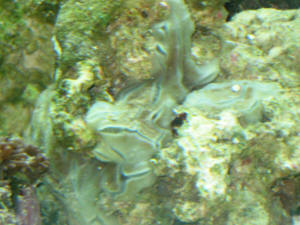 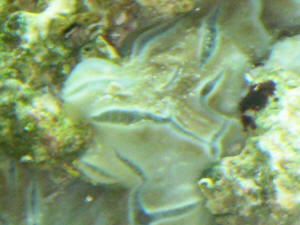 |
|
Predatory Tunicate? More Likely a
Sponge -- 2/5/10
Thanks for getting back.
<You're welcome.>
I know my camera is bad.
<If you are using a traditional camera (Not a phone) it might
have a "Macro" setting, usually is a symbol that looks
like a flower. This setting will take clearer up close
photos.>
the only other thing I think might help you is that it
doesn't have a shape, but instead as it grows it takes the
shape of the rock.
<Supports the belief that this is a sponge.>
also at some spots (couldn't get a clear image of
them),instead of the mouth being all web it has a hole the size
of a pencil tip in the center of the webbing. Its never afraid
when I come around it,
<Sponges don't really react much.>
if it wants to eat and I am around it will still eat. One more
thing if it is a sponge is it reef safe?
<More or less. Sponges can be a sign of excess nutrients in
your system.
Mich>
|
|
Hydroid? (Nope'¦Syconoid) --
01/28/09
Greetings again WWM crew,
<<Howdy Nick>>
You have always been so kind and helpful.
<<Is our pleasure to serve>>
I just noticed a few of these in my pico tonight, and tried the
hitchhiker ID sites without luck. They are about 1/2 cm and they
are only under rocks in shaded areas. The small Zoanthids on the
left are for size comparison. If you tell me what these are, I
will search the web on how to best get rid of them.
<<Well Nick, if you are referring to the small white
spherical object attached to the underside of the rock toward the
upper right of the photo (I don't espy anything
else)'¦it's a Syconoid sponge. These 'can
grow' to a few centimeters in diameter 'and are
harmless if not beneficial. No need to worry here>>
Thank you in advance,
Nick N.
<<Happy to share'¦ EricR>>
|
 |
|
Sponge ID -- 01/03/10
I didn't find any info on Eudistoma obscuratum in the sponge
section. I ordered a sponge, called a Red Velvet Sponge, after
being assured by the supplier that it was of the easiest care
level.
<... no, not so>
It was listed as a Eudistoma obscuratum,
<Mmm, no>
but it sure looks similar to Mycale laxissima.
<Mmm, maybe>
I wasn't able to find any useful care info on the Eudistoma
obscuratum, and the few pictures I located look nothing like my
specimen. (Except, of course, for the photos provided my
supplier.) What do you think? Thanks for your help.
<Oh... where to start here... Have you read our scant coverage
re Poriferans in aquariums? Mainly this last page/file:
http://wetwebmedia.com/spongesii.htm
below... and the linked FAQs files above. As you'll find, the
non-photosynthetic sponges (gauged by general colour in this
case) are not easily maintained under most captive conditions;
and some have dire metabolic activities. I would return this
specimen. Bob Fenner>
|
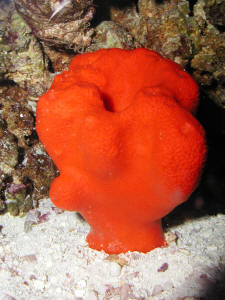 |
|
A larva (?) I can't find an ID for
12/25/09
Greetings to everyone!
<Happy holidays!>
Aprox 2 wks ago I noticed some white specs in my skimmer and
decided to wait to ID (let them grow). Yesterday during
maintenance I discover they have indeed grown. I have attached 3
pics with some in focus areas (round
does not focus well in my camera...sorry.) In water they have
what appears to be a foot for anchoring and the pointed end in
the first 2 photos is actually open in water. (but not as much as
a feather duster would be, km.)
Any thoughts as to their ID, and should I let them be or
sterilize?
<I'd leave them be>
All the best of the season to everyone and their families at
WWM!!
Richard J.C.
<Thanks Richard. These look to be "Syconoid" sponges
to me. Harmless. Bob Fenner>
|
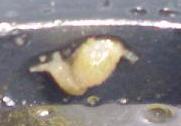 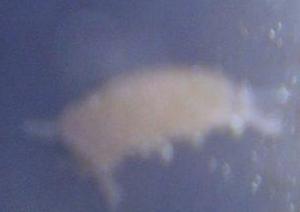 |
|
Sponge question and worms: It is a Sponge:
Sponge ID 12/14/2009
Hi WWM
<Hi Kody.>
I have had my saltwater aquarium for about 8-9 months, its 90gal
with a Fluval external canister, and has 2 Koralia 4 fans in
it.
<OK>
I have 70lbs of live rock and 30lbs of live sand and recently I
have notice that on the live rock, little white, spongy worm like
things coming out of the rock. I was hoping you guys could help
identify these and whether or
not I should be worried about them. And also on parts of the live
rock I have notice a yellow sponge type thing start growing on
the surface of the rock, again is this anything to worry about or
is it just a sponge that has started to thrive?
<The little white things are called Syconoid sponges and they
are harmless.
Without a picture I can't identify the yellow sponge. Have a
look here:
http://www.wetwebmedia.com/sponges.htm and the linked pages at
the top of that page and see if you can identify it>
Thanks Kody
<MikeV>
Re: Sponge question and worms: It is a Sponge: Sponge
ID Likely a Clathria sp.12/15/2009
<Hi Kody>
Here is a picture of the sponge that is growing on the live rock,
its like a light yellow color and I couldn't find anything
that looks exactly like this in your link you sent me. Sorry the
picture is kind of dark, I really hope you can help =]
<By the picture, my best guess is one of the Clathria sp.
sponges. Refer to the pages I sent you before (
http://www.wetwebmedia.com/sponges.htm ) for their care. Enjoy
your free hitchhiker.>
Thanks Kody
<MikeV>
|
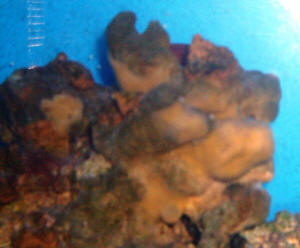 |
|
Sponge ID, incomp. 12/2/09
Hi WWM Crew,
<Steve>
Thanks in advance for your time and dedication sharing your
knowledge and wisdom (again).
<Given our background, passion, compassion, other make-up,
this is a most-natural course>
My 150G mixed tank has been running for about 2 years now. When
first set up I added about 50KG of new (matured) live rock to
about the same from my previous smaller tank).
<Okay>
As usual I looked in wonder at the "Free" life that
hitched a ride on this rock and was very pleased to see some of
this grow into established colonies in my now mature tank.
<Good>
The pics below are what I believe to be a sponge that over the
last 2 years has grown from a tiny speck to approaching 12"
across. It is white at the base but dark brown all over the rest
due to possible algae growth ? (but
it has always looked like this even when very small)
<Neat!>
I have noticed that some of the zooids have migrated away (or
died back) from this (but not completely, as evident in the
photo).
<I see>
The reason for my mail, is that for the first time I had need to
move some rocks recently (actually adding a little more) when my
hand brushed against
this sponge. I was very surprised to find it was not the lovely
smooth velvety texture I imagined but covered in tiny hooks and
barbs that seemed to stick into my skin and certainly bloody
stung !
<Many sponges are indeed not what they appear... Some are very
toxic to touch, others are dangerously noxious chemically to
their tankmates. It should be obvious to folks looking at their
behavior, dominance in many reef situations that these early
forms of life have "mechanisms" for securing space,
competing...>
I'm now concerned that this may not be the harmless free
addition I first though it was and would appreciate your thoughts
?
Thanks again for your help
Regards
Steve Burkinheath
<Mmm, I can't place the genus even here, but I've
encountered something like this in aquariums before. If it were
me, mine, I'd really consider taking out the rock all this
sponge is on... and with gloves and a few sharp tools, knives at
the ready, excising it from the rock... and yes, toss it. I am
more concerned with the long/er term issues of toxicity here,
even your health, than the value of this Poriferan as an
ornamental. I am sorry if I'm being too blunt, perhaps appear
callous here, but like grading school papers, I adhere to a
"if in doubt, count it out" rule where potentially
toxic life is concerned. I have found it pays to shy on the side
of conservatism in such matters.
Bob Fenner>
|
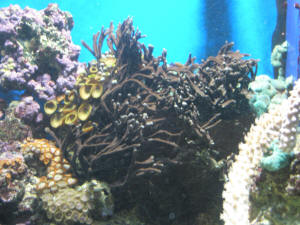
 |
|
|

